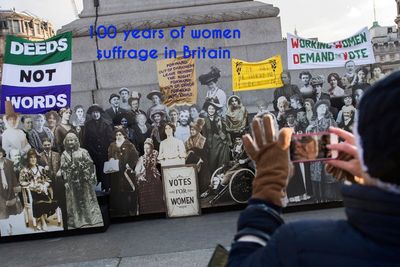LONDON — A century after they won the right to vote, British women celebrated their gains on Tuesday but took a gimlet-eyed view of their status in modern-day Britain.
In recent months alone, there have been revelations of sexual harassment in the hallowed chambers of Parliament; a scandal at the Presidents Club, where hostesses were reportedly harassed and assaulted at a men-only charity dinner; the disclosure of gender pay gaps at the BBC; and the resignation of a Labour politician who accused the party of sexism after some members heckled her by singing a song about stalking.
The anniversary seemed all the more meaningful because it was taking place in the midst of the #MeToo movement in Britain. Julianne Hughes-Jennett, a lawyer emerging Tuesday from an exhibit on the suffragist movement at the Museum of London, tried to take the long view.
"One hundred years in the context of history is a drop in the ocean," she said.
Not all women won the right to vote when the Representation of the People Act passed on Feb. 6, 1918. It conferred eligibility only on female property owners age 30 and older, the culmination of years of campaigning and militancy by leaders such as Millicent Fawcett and Emmeline Pankhurst. It took a decade more before Britain extended the vote to all women 21 and over.
Since then, much legislation has been passed to advance women's equality. Ms. Hughes-Jennett, wearing the suffragists' white, green and purple ribbon on her jacket lapel, pointed to the Equal Pay Act in 1970. "But it still takes a while for culture to catch up with the law," she said.
Greta Brandler, 102, who was 2 when the first voting act was passed, reminded listeners on a BBC television program how much more needed to be done. "Men are control freaks," she told the broadcaster, without a trace of irony. "Look at what we've got in Parliament — 7-year-old boys squabbling and fighting."
Ms. Brandler said, "Women have moved closer to the glass ceiling, but a woman has to be twice as good to be equal to a man."
The irony of the BBC's coverage was not lost on some British viewers, who criticized the broadcaster on Twitter for covering the centenary even, they said, as it denied some of its female employees the same salaries as their male counterparts.
Britain's suffragist movement emerged in the late 19th century, when Parliament extended the franchise to greater swaths of the male population while continuing to deny it to women. The National Union of Women's Suffrage Societies, made up mostly of middle-class women, was formed in 1897, eventually becoming the biggest suffrage organization, with 50,000 members.
Originally, under the leadership of Fawcett, the movement was largely moderate. But it eventually split, with a more militant faction, the Women's Social and Political Union, forming under by Pankhurst.
Pankhurst, who was arrested numerous times, led angry street demonstrations at which hundreds of suffragists were arrested. Beginning around 1910, their tactics became quite violent, including arson attacks and the bombing of the house belonging to the chancellor of the Exchequer, David Lloyd George.
One suffragist, Mary Richardson, slashed a painting at the National Gallery in London with a meat cleaver. A Sikh princess, Sophia Duleep Singh, threw herself in front of the prime minister's car.Those actions have stoked a debate lately over whether the women should be considered "terrorists." The Labour leader Jeremy Corbyn addressed that issue on Tuesday, pledging to pardon them posthumously if he ever claims the prime ministership.
Earlier in the day, the original Representation of the People Act was wheeled out in Parliament for the first time. And in Manchester, birthplace of the suffragist movement, Prime Minister Theresa May talked about the women who "persevered in spite of all danger and discouragement because they knew their cause was right."
Mrs. May also appeared in Parliament for a photograph with all of its more than 200 female members.
We've made good progress," Britain's home secretary, Amber Rudd, said on Twitter. "But there's more to do to help women in politics."
Across London, people thronged around Parliament and Trafalgar Square, where 59 life-size images of prominent suffragists were displayed.
The government is spending $1.4 million to erect statues of women across the country. In April, Fawcett will become the first woman to be so honored in Parliament Square. A statue of Pankhurst will go up in Manchester, the city's first new monument to a woman in more than 100 years.
On Trafalgar Square on Tuesday, a group of high school seniors was taking selfies by the suffragist portraits. The students, from outside London, had just visited Parliament, where it was all about a "bunch of guys," said Sarah Pierce, 17, who wants to become a psychologist.
"There was that guy, then this guy," she said. "Oh, and then there's that guy's wife."
"It's a whitewashed, malestream' version of history," said Fiona Tuite, 17, who said she wanted to pursue diplomacy. "We still haven't come that far. You'd think that in a hundred years you'd have equal rights around the world."
Still, she said, the achievements so far have been "quite fantastic."
New York Times, February 6, 2018
###
February 7, 2018
Post Script. 1. more on British suffrage news. As the article above notes, British Suffragist Millicent Fawcett was announced to be the First Woman to get a statue in London's Parliament Square this past April, 2017. https://nyti.ms/2nLa7dA
2. In the teens of the twentieth century, the shouts for women's suffrage were heard round the world. Denmark granted women's suffrage in 1915. Near the end of the war, Canada, Russia, Germany, and Poland gave women the right to vote. Propertied British women over 30 had the vote in 1918, Dutch women in 1919, and American women won the vote on 26 August 1920 with the passage of the 19th Amendment.
The fight for equality continues
